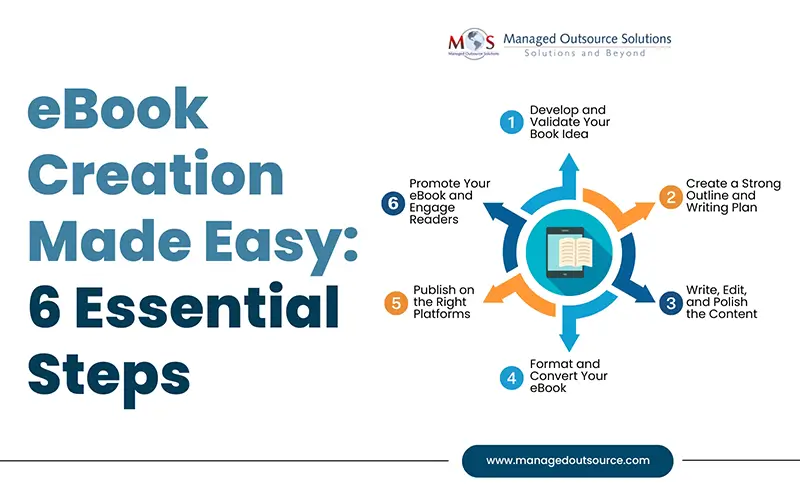Every bestseller starts with a single idea — a concept or plot scribbled in a notebook, a story stored in your mind, or a message you’re eager to share with the world. In today’s digital age, you no longer need to consider a traditional publishing deal for the production, marketing, and distribution of your book ideas. With their convenience, eBooks are leading global reading trends. Authors can now easily self-publish, distribute, and market their books online to millions of readers with the support of professional eBook conversion services.
Turning your simple ideas into a polished, market-ready eBook takes more than just writing skills. It requires thoughtful planning, proper formatting, effective design, and strategic publishing. This guide shares a step-by-step process and best practices to successfully transform your book ideas into an eBook that not only captures attention but also drives sales and helps you stand out as a writer.
Transform your ideas into an eBook today with customized eBook conversion services.
Steps to Convert your Book Ideas into an eBook
Here are 6 steps to create an eBook from scratch:
Step 1: Develop and Test Your Book Idea
The first step is to research your audience and interest in your topic. Before you start writing, take time to think about what sets your book apart. Every successful book offers readers something unique — this could be a fresh viewpoint, a helpful solution, or an inspiring story. It’s important to have a clear, well-defined concept. Once you have a clear idea about your topic and audience, it becomes much easier to plan your chapters, tone, and writing style.
Before you start writing your eBook, find out if there’s real interest in your idea. Conduct keyword research using tools like Google Trends or Ubersuggest to understand how often people search for topics related to your idea. High search volume usually means strong reader interest. Being active on reader communities like Goodreads, Reddit, or Facebook writing groups will also help you see what readers are discussing.
Step 2: Create a Strong Outline and Writing Plan
Once your idea is clear, the next step is to organize it into a clear, workable plan. Start by breaking your book into chapters or sections, each focusing on a key point, story event, or takeaway. This helps you keep your writing on track.
Next, set realistic goals such as, writing 500–1,000 words a day or finishing one chapter per week. Setting small, achievable targets keeps you motivated and makes the process less overwhelming.
Finally, set a writing timeline that fits your schedule. Consistency matters more than speed, whether you prefer to write early in the morning, at night, or during weekends.
Writing tools like Scrivener, Google Docs, or Notion offer a range of features to help organize large amounts of information and structure your work. Choose the tool based on your needs. For example, Scrivener is a great option for advanced organizing, Notion offers flexible content management, and Google Docs facilitates real-time collaboration.
Step 3: Write, Edit, and Polish Your Manuscript
Now that you have strong ideas that appeal to a specific group of readers, start your project by creating an outline for each chapter. This makes structuring your eBook much easier later on. Don’t worry about writing the chapters in order, just put your ideas down as they come. Once all the chapters are drafted, you can organize them into a logical flow.
If you’re repurposing content from blog posts, emails, or essays, compile everything into a single document first. Then read through it to ensure a smooth and consistent flow.
Whether you’re writing from scratch or collecting existing material, it’s crucial to craft a compelling introduction. A strong intro grabs attention, especially in features like Amazon’s “Look Inside,” where readers decide whether to dive in.
Finally, once your eBook is complete, take the time to proofread it carefully for spelling, grammar, and clarity. Errors in your ebook can damage your credibility and result in bad reviews, poor readability, and fewer sales. Editing and proofreading your book before converting it to an electronic format is crucial for correcting errors and preventing technical and formatting issues.
In addition to Grammarly and Hemingway, there are grammar and style tools that offer specialized features for creative and long-form projects. Tools such as ProWritingAid, Wordtune, and apps like Scrivener help with deeper analysis, rewriting, and manuscript organization. A polished manuscript not only looks professional but also keeps readers engaged from start to finish.
Step 4: Convert and Format Your eBook
Proper formatting is key to eBook publishing. There are different types of ePub formats. EPUB, MOBI, and PDF are the most common formats and differ in flexibility and use. To determine the format for your project, you need to determine which platform or marketplace you are going to publish your eBook. Each platform has specific requirements. Your book should look professional across all platforms: Kindles, Nooks, iPads, smartphones, etc.
EPUB is the standard, reflowable format for most e-readers, making it ideal for ideal for most books and devices. MOBI was Amazon’s older Kindle format (now replaced by proprietary formats like AZW3), while PDF preserves exact formatting but is less flexible on smaller screens. PDF is best for documents where the layout must remain fixed. Tips for eBook formatting:
- Start by leaving plenty of white space — use wide margins, a comfortable font size, and enough spacing between lines and paragraphs to make the text easy to read.
- Include headers, footers, and page numbers to give your eBook a polished, structured feel. Don’t forget essential sections like a table of contents, copyright page, and an “About the Author” section with a clear call to action.
- Add images, graphics, or illustrations to make your content more visually appealing and break up long blocks of text, keeping readers interested from start to finish.
While ebook converters are available, using professional ePub conversion services ensures your book displays correctly on all devices, whether it’s Kindle, Apple Books, or other platforms. Beyond conversion, experts in the field will take care of cover layout, typography, and image optimization, ensuring a clean, visually appealing design. They can ensure a visually appealing cover that’s easy to read, captures attention instantly, and gives readers a clear idea of your book’s content and style.
Step 5: Publish on the Right Platforms
There are various eBook publishing platforms Amazon Kindle, Apple Books, Kobo, and Smashwords. Do your research, consider royalties and pricing strategies, and choose the right option or options for publishing your work.
Take the time to research popular keywords and categories in your genre to give your book the best chance of being found by the right audience. Metadata, including your title, subtitle, description, keywords, and author name, helps your eBook get discovered by readers. Choosing the right categories ensures it appears in relevant searches and bestseller lists, boosting visibility.
Additionally, don’t forget that an ISBN and copyright for eBooks is essential to ensure they are properly recognized and trackable in digital marketplaces.
Step 6: Promote Your eBook and Engage Readers
Spread the word about your eBook through social media, your author website, and email newsletters to reach a wider audience. Encourage readers to leave reviews and share feedback, and consider using promotional campaigns or sites like BookBub and Goodreads to boost visibility and engagement.
Transform Your Ideas into an eBook with the Right Support
Converting your manuscript into an eBook format is achievable with eBook conversion tools and the right plan. Partnering with a professional eBook conversion company can simplify the process. Experts can ensure well-formatted text, readable fonts, eye-catching design, and optimized metadata, ensuring your work is visually appealing. A polished, professional look will make your eBook stand out on all major platforms and reach the right readers.





